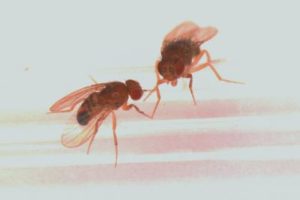fly
Shining a light on trypanosome reproduction
The research could eventually lead to new approaches for controlling sleeping sickness in humans and wasting diseases in livestock which are caused by trypanosomes carried by the bloodsucking tsetse fly.
Biologists believe that sexual reproducti…
Partnership of genes affects the brain’s development
The human brain consists of approximately one hundred billion nerve cells. Each of these cells needs to connect to specific other cells during the brain’s development in order to form a fully functional organism. Yet how does a nerve cell know w…
Microfluidic device rapidly orients hundreds of embryos for high-throughput experiments
Researchers have developed a microfluidic device that automatically orients hundreds of fruit fly and other embryos to prepare them for research. The device could facilitate the study of such issues as how organisms develop their complex structure…
Fruit fly study digs deeper into poorly understood details of forming embryos
CINCINNATI — Using fruit flies as a model to study embryo formation, scientists report in Nature Cell Biology that molecular breakdown of a protein called Bicoid is vital to normal head-to-tail patterning of the insect’s offspring.
Published onl…
Sign languages help us understand the nature of metaphors
(Washington, DC) — A recent study of the use of metaphors in spoken language and various sign languages shows that certain types of metaphors are difficult to convey in sign language. The study, “Iconicity and metaphor: Constraints on metaphorical…
Do our bodies’ bacteria play matchmaker?
Tel Aviv ― Could the bacteria that we carry in our bodies decide who we marry? According to a new study from Tel Aviv University, the answer lies in the gut of a small fruit fly.
Prof. Eugene Rosenberg, Prof. Daniel Segel and doctoral stude…
Laser micro-scalpel yields biological insights into nature of tissue
Using a laser beam scalpel so fine it could inscribe words on the surface of a fly egg, researchers have snipped their way to a new understanding of a key process in a fruit fly’s embryonic development. The process, called dorsal closure, is the complex mechanism by which the embryonic skin of the fruit fly Drosophila knits itself together to protect its innards from the outside world. Understanding this seemingly arcane process is important because dorsal closure uses molecular and cellular mechanisms very similar to those involved in wound-healing as well as those that can go awry in humans to produce the spinal malformation spina bifida.
Pavlov?s Flies: Researchers Identify Fruit Fly Memory Mutants
By teaching fruit flies to avoid an odor and isolating mutant flies that can?t remember their lessons, researchers at Cold Spring Harbor Laboratory in New York have identified dozens of genes required for long-term memory. In the same study, using DNA chip technology, the scientists identified another large group of candidate memory genes that are either switched on or off in the fly brain during memory formation.
Come fly with me
 Boeing has joined a small group of technology bigwigs trying to test a theory that would let engineers negate some of the effects of gravity. The American aerospace giant is using the work of controversial Russian scientist Yevgeny Podkletnov, who claims to have developed a device that can shield objects from the Earth’s pull. Other researchers claim Podkletnov’s work is hokum, but considering the cost savings such a device would represent for air travel, Boeing seems intent on getting to the bottom of it all. The Russian says he found that objects above a superconducting ceramic disc rotating over powerful electromagnets lost weight, the BBC reports. “The reduction in gravity was small, about 2 percent, but the implications — for example, in terms of cutting the energy needed for a plane to fly — were immense.”
Boeing has joined a small group of technology bigwigs trying to test a theory that would let engineers negate some of the effects of gravity. The American aerospace giant is using the work of controversial Russian scientist Yevgeny Podkletnov, who claims to have developed a device that can shield objects from the Earth’s pull. Other researchers claim Podkletnov’s work is hokum, but considering the cost savings such a device would represent for air travel, Boeing seems intent on getting to the bottom of it all. The Russian says he found that objects above a superconducting ceramic disc rotating over powerful electromagnets lost weight, the BBC reports. “The reduction in gravity was small, about 2 percent, but the implications — for example, in terms of cutting the energy needed for a plane to fly — were immense.”

